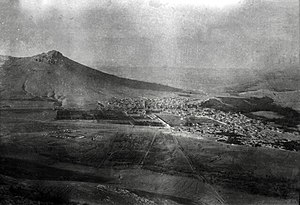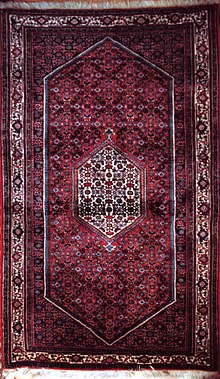Bidschar
| Bidschar | ||
|---|---|---|
| Bidschar during the First World War in the early 20th century | ||
|
|
||
| Basic data | ||
| Country: |
|
|
| Province : | Kordestān | |
| Coordinates : | 35 ° 52 ' N , 47 ° 37' E | |
| Height : | 1920 m | |
| Residents : | 47,537 (2012) | |
| Time zone : | UTC +3: 30 | |
Bijar (also Bijar , Persian بيجار Bijār ) is a city in the Iranian province of Kordestān. It had an estimated 46,156 inhabitants in 2006. Because of its location at 1920 m altitude , Bidschar is also called the roof of Iran . The city lies on an old trade route from Hamadan to Tabriz .
The following places are part of the Bijar district: Bijar (46,156), Yasukand (3268), Tup Agaj (2172), Pir Taj (1451), Cheschmeh Mantesh (1012), Khandan Quli (1003), Zeynal (915), Seydan ( 893), Khorkhoreh (872) and Baba Rashani (481).
The majority of Bijar's residents are Kurds . Bidschar is internationally known for its elegant and old carpets (→ Persian carpet ) and textiles. The word Bidschar could be a variation of the Kurdish word Bajar / Badschar for city and the full name of the city is Bidschar-e Garrus. Among the other accepted derivatives of the name Bidschar, there is Bid-zar (Land of Willow Trees) which is linguistically unusual.
history
Historically, Bijar was part of the Garrus administrative unit. Before the creation of Zanjan Province by the Pahlavi regime after the First World War , the Garrus region included Suhraward , the birthplace of Shahab al-Din Suhrewardi , who was a well-known Enlightenment philosopher.
The city is mentioned in the 15th century as a village that belonged to the first Safavid ruler Shah Ismail . Bidschar grew into a city in the 19th century. During the First World War it was besieged and occupied by Russians, British and Ottomans. The population sank drastically due to war and hunger. In 1914 it was around 20,000 and in 1976 it was 17,224.
Architecture and culture
The historical castle Qam Cheqay in the Valley of the Kings, 45 km from Bidschar, probably dates from the time of the Medes and is the oldest castle in Kordestān. The castle was used until the Sassanid period and was an example of archaic architecture in Kordestān.
Another historical building is the Emamzadeh Aqil in Hasanabad (Yasukand) 45 km east of Bijar and one of the remaining Seljuk buildings. The square building (6 × 6.5 m) with its collapsed dome was the repository for Islamic religious texts in Kufi script .
Bidschars Markt (→ Bazaar ) with its unique design is one of the city's attractions. The covered market was built during the Qajar era and is much younger than the Old Market in Sanandaj from the Safavid era. The market in Bidschar consists of a covered main street in north-south direction, an eastern part ( Timcheh-e Haj Shahbaz ) and a western part ( Timcheh-e Amir Toman ).
Iran's Payam Nur University has opened a branch in Bijar and the Garrus Research Center is attached to the university.
Carpet art
Bidschar and the surrounding area are a center of carpet production. Bidschar rugs enjoy a special reputation due to their fine and very robust weave. They are particularly strong because the weft threads are wrapped in an iron comb when they are moistened. Since this is very exhausting, Bijar carpets are often knotted by men. The warp and weft are made of cotton , the pile is made of wool , and fine specimens made of cork wool. The Turkish knot is used . They are mostly not made in factories , but in home work according to the individual ideas of the knotter. This makes them lively and expressive.
A characteristic feature is the use of a version of the Herati pattern , which includes a small rosette in a rhombus . This basic pattern often runs through the central medallion (with a characteristic light outline), but in this case changes color. Other versions of Bidschar carpets use floral motifs, most notably a large eight-leaf rosette. Mostly red and blue tones dominate. The finest Bijar carpets are not knotted by the Kurds, but by the descendants of the Afşar , in the village of Tekab approx. 50 km west of Bijar.
Personalities
Well-known politicians and army officers in the Iranian army came from Bijar. Amir Nezam Garrusi (1820–1900) was born in Bidschar and comes from the Kabudvand family. As a colonel of the regiment in Garrus, he accompanied Naser ad-Din Shah on his unsuccessful campaign against Herat . As a diplomat in Paris, he met Napoléon III. and later worked as an Iranian diplomat in Istanbul . As a general, he participated in the suppression of the Kurdish uprising of Naqschbandi Sheikh Ubeydallah in 1880. He also played a role in the murder of Cewer Aghas, the predecessor of the Kurdish leader Simko .
The ancestors of Gholamali Bayandor , the first commander of the Iranian fleet , also come from Bijar .
The actor Farhad Aslani was born in Bidschar . Dr. Ramezanzadeh, spokesman for the government of Mohammad Chātami , has family ties with Bijar.
Among the academics from Bidschar is Dr. To mention Kamran Nejatollahi , a young professor of engineering at the Polytechnic University in Tehran, who was shot dead in 1979 by SAVAK riflemen at the university during a sit-in. In June 2008, 21-year-old Hana Abdi , a former student of Payam Noor University in Bidschar and a member of the AzarMerh women's association, was sentenced to 5 years in prison in Kordestān. According to her lawyer Sharif, the Iranian Revolutionary Court has charged her with threats to national security.
Individual evidence
- ↑ Archived copy ( Memento of the original dated December 29, 2011 in the Internet Archive ) Info: The archive link was automatically inserted and not yet checked. Please check the original and archive link according to the instructions and then remove this notice.
- ↑ Page no longer available , search in web archives:
- ^ Encyclopedia Iranica
- ↑ PRJ Ford: The oriental carpet and its patterns . Bechtermünz-Verlag, Augsburg 1997, pp. 87-91, 331-332.
Web link
- Bidschar . In: Ehsan Yarshater (Ed.): Encyclopædia Iranica (English, including references)



